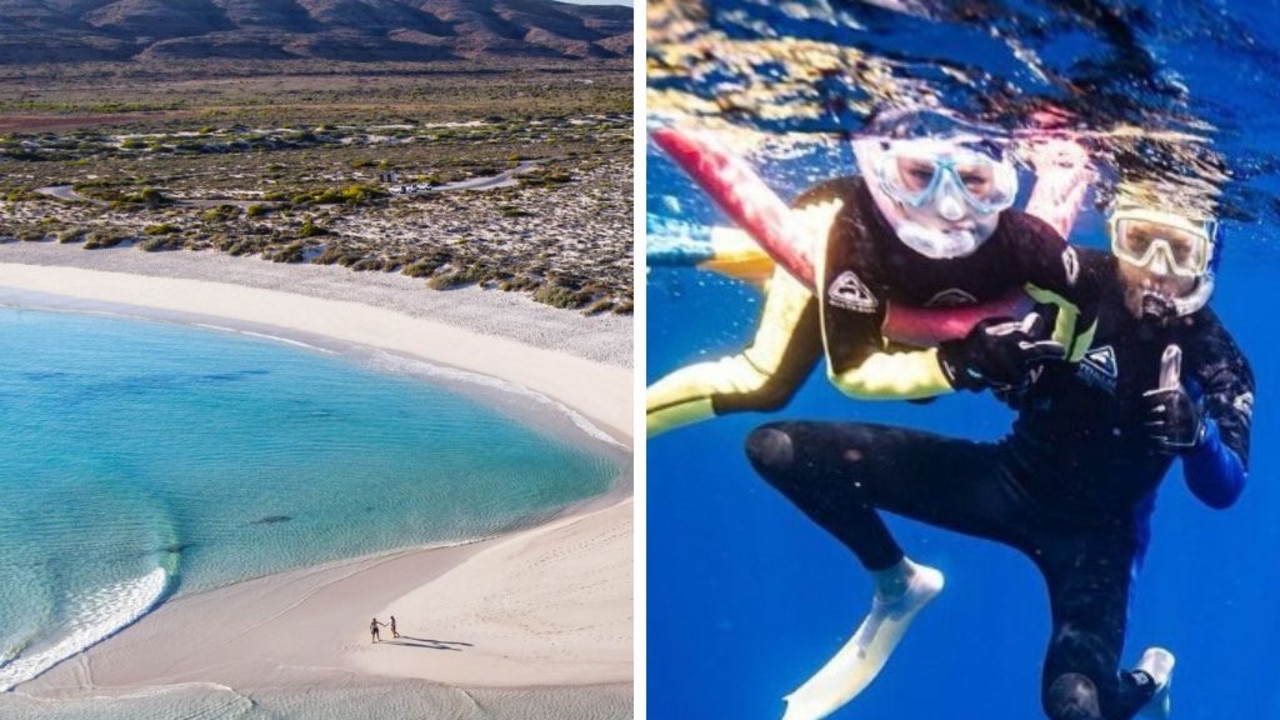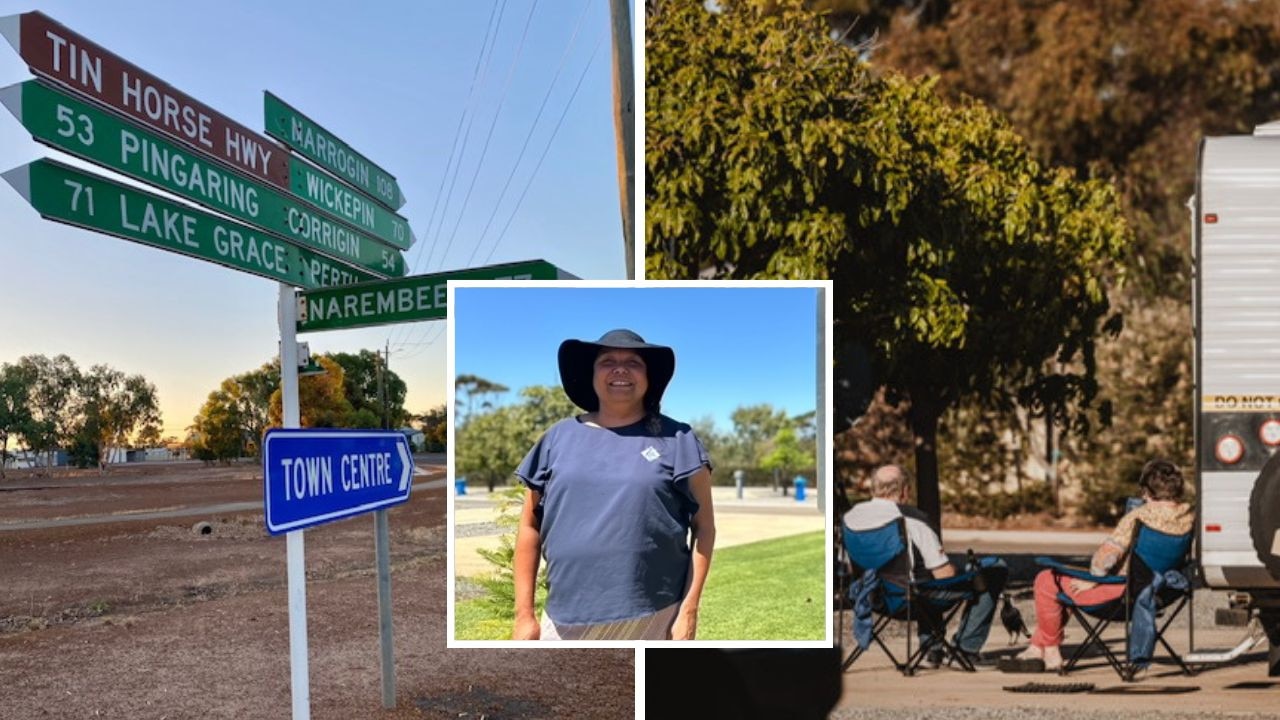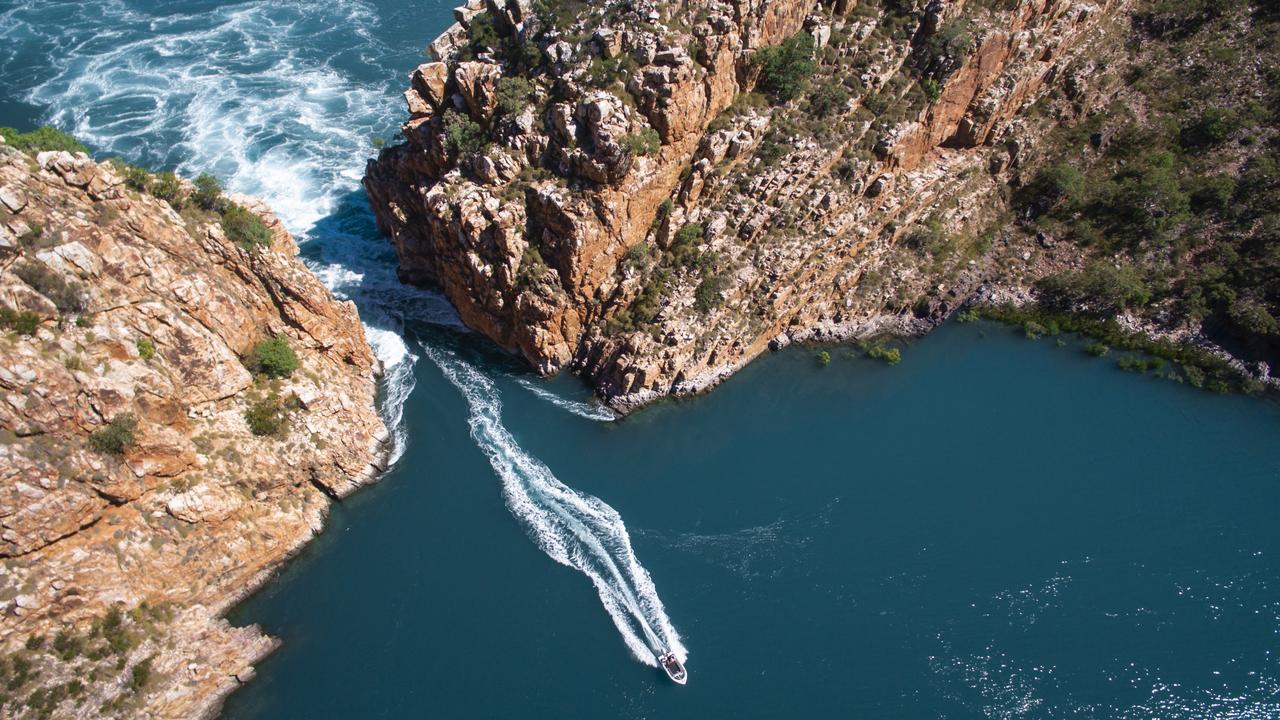12 must-see locations in northern Western Australia
DO YOU need some help deciding where to go for your next caravan or camping holiday? Here are some suggestions.

DO YOU need some help deciding where to go for your next caravan or camping holiday? Here are some suggestions.
THE CORAL COAST
KALBARRI NATIONAL PARK — 150KM NORTH OF GERALDTON
The Kalbarri National Park surrounds the lower reaches of the Murchison River, which has cut a magnificent 80km gorge through the red and white banded sandstone to create formations such as Nature’s Window.
In 2014, the $7.7 million upgrade of Kalbarri National Park, mainly funded under the Royalties for Regions infrastructure and roads initiative, was completed and officially opened. The upgrade included sealing 12km of The Loop/ Z-Bend Rd and the construction of new visitor facilities at The Loop and West Loop at the Murchison Gorge, including shade shelters, lookouts, walking trails, visitor information areas, sealed carparks and toilets.
SHARK BAY WORLD HERITAGE AREA — FROM 10KM EAST OF DENHAM
Inside the Shark Bay World Heritage area are a number of great sites including the Francois Peron National Park. Known for its contrasting red cliffs, white beaches and blue waters, the park has a fascinating pastoral history and offers a wilderness experience to 4WD drivers.
Inside the national park is the Big Lagoon Campground, an attractive turquoise lagoon with a small campground and an excellent spot to explore by canoe or sea kayak. The campground has gas barbecues and toilets and a nearby site for launching boats. You are welcome to fish in the lagoon south of the camping area. Camping fees apply.
Also on offer in the Shark Bay World Heritage area is the Hamelin Pool, one of just a handful of places in the world with stromatolites (the oldest living organisms known on earth), and Monkey Mia where visitors can stand within metres of wild bottlenose dolphins.
MOUNT AUGUSTUS — 480KM NORTH-EAST OF CARNARVON
Mount Augustus is the largest monocline rock in the world and is found in the Mount Augustus National Park. The monocline rock is 8km long and 3km wide — about two and half times the size of Uluru. There is no camping allowed within the national park but the nearby Outback Tourist Park offers accommodation, basic supplies and fuel.
THE PILBARA
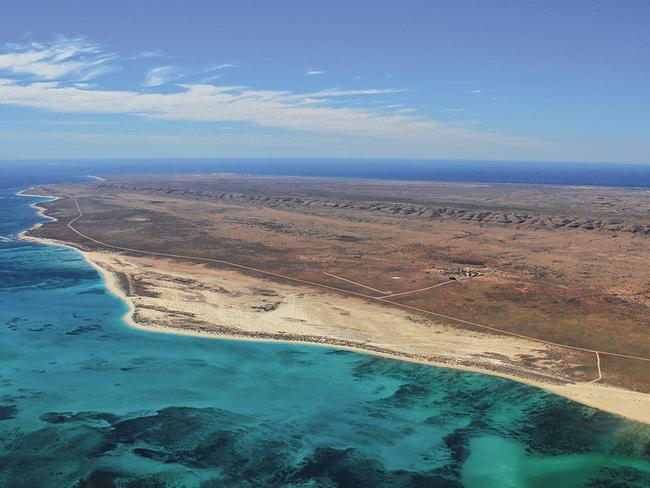
KARIJINI NATIONAL PARK — 75KM EAST OF TOM PRICE
The Karijini National Park is home to some of the oldest rock formations in the world, dating back two and a half billion years. The park features a labyrinth of gorges — some so narrow you can reach and touch the cool rocks on either side and others so large they appear like massive natural amphitheatres carved into the rock. Emerald pools stand in stark contrast to the rust-red and deep purple of the rocks and the landscape.
A $1.8m redevelopment of the Hamersley Gorge day-use area in Karijini National Park was completed last year, funded through Royalties for Regions program with contributions from the Department of Parks and Wildlife and Rio Tinto.
The redevelopment includes improved road access, new signs and the construction of a shade shelter and toilet.
Dales campground is close to some of Karijini’s most popular sites including Dales Gorge, Circular Pool and Fortescue Falls. A new staircase to Dales Gorge was completed in 2014 with improved access for visitors. Further sections of staircase are planned for 2015. There are a range of walk trails from the campground to view and explore lookout points, pools and gorges and 140 campsites in the park accommodating tents, large caravans, camper vans and camper trailers.
The western section of Banjima Dr was sealed in 2014 by the Shire of Ashburton, which improves access to the western gorge sites of Weano, Hancock and Oxer.
NINGALOO MARINE PARK — 50KM WEST OF EXMOUTH
Escape the southern winter and dive into the Ningaloo Marine Park, staying at one of the many campgrounds nestled on the coast in Cape Range National Park. Snorkel with turtles, dolphins, dugongs, manta rays, colourful fish and corals or take a land-based adventure looking for black footed rock wallabies, birds, reptiles and much more. In season (April to July) whale sharks, the world’s biggest fish, congregate along the Ningaloo Reef.
The chance to snorkel with these gentle giants is the opportunity of a lifetime and visitors from all over the world head to the Ningaloo Reef during whale shark season.
Kurrajong campground in Cape Range National Park, has 26 new campsites, a new gravel road, lookout points, a barbecue shelter and toilets plus an additional 19 new campsites in other areas of the park.
Demand for campsites is extremely high with advance booking required. Booking is only available through the ParkStay WA website parkstay.dpaw.wa.gov.au
Most of the campsites in Cape Range National Park are easy to get to by conventional vehicle, but if you’re after something a little more remote then One K campground is the site to go to. Once you cross Yardie Creek, on soft, shifting sand so high clearance campers and 4WDs only, you can access the campground.
MILLSTREAM CHICHESTER NATIONAL PARK — 150KM SOUTH-EAST OF KARRATHA
The Millstream Chichester National Park is an oasis in the desert, nestled within the chocolate brown rocks of the Chichester Range, dotted with spinifex and snappy gums. Permanent pools are fed by springs that draw water from the underground aquifer within porous dolomite rock. Miliyanha and Stargazers campgrounds are both located in the park with barbecue facilities and use of personal gas cooking appliances welcome. Campground hosts are stationed in both campgrounds for the majority of the tourist season, typically between mid-April and early October.
THE KIMBERLEY
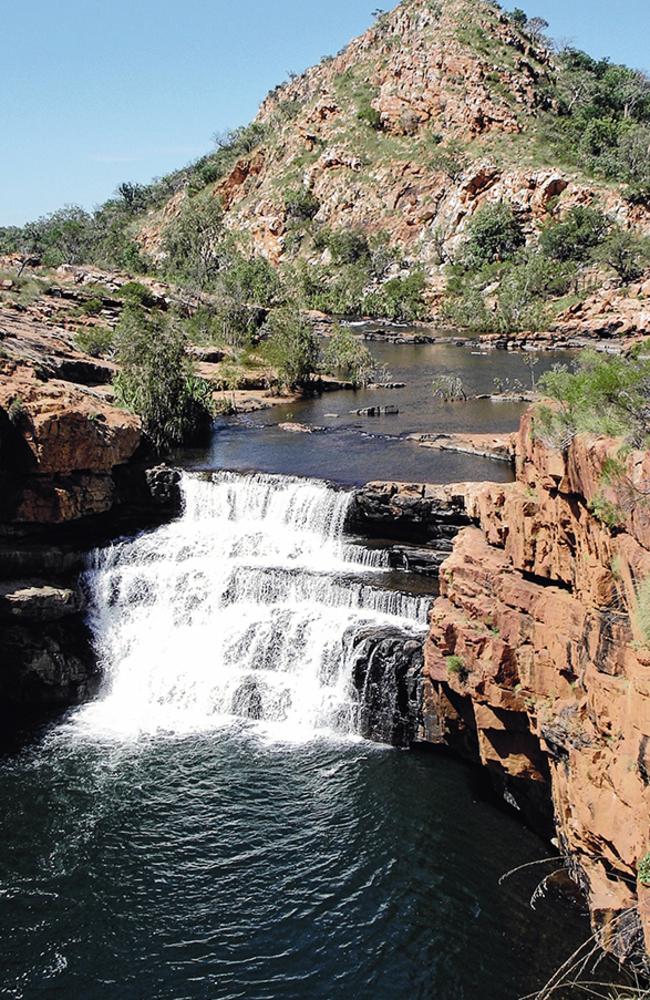
WINDJANA GORGE NATIONAL PARK — 140KM EAST OF DERBY
The Windjana Gorge National Park is one of the Kimberley’s most stunning gorges with water-streaked walls which rise majestically to heights of approximately 100m. The 3.5km long gorge cuts through the Napier Range, part of the ancient Devonian limestone reef dating back 350 million years. Freshwater crocodiles bask in the pools, while fruit bats and corellas roost in the waterside trees.
Windjana Gorge Campground has good facilities but no powered sites. It is a great base from which to explore Windjana Gorge. Entrance and camping fees apply.
KING LEOPOLD RANGES CONSERVATION PARK — 250KM NORTH-EAST OF DERBY
The King Leopold Ranges Conservation Park is known for its spectacular Bell Creek and Lennard gorges. The ridges of the King Leopold Ranges rise 300m above the surrounding plains (and 950m above sea level) while open savannah woodlands cover the sunburnt landscapes. Groves of river gum, stately paperbark trees and dense thickets of screw pine shade watercourses as water lilies and other aquatic plants fill permanent pools in the creeks and rivers, providing cool relief from the starkness of the harsh escarpments.
Following wet season rains, great volumes of water cascade from the ranges. In the dry, tourists are attracted to the spectacular cascading waterfalls at Bell Creek Gorge which is a relaxing place to swim. Visitors also marvel at the spectacular Lennard River Gorge and the incredibly folded and faulted scenic rock formations of the ranges along the Gibb River Rd, shaped by tremendous geological forces. The range is a haven for bird life and offers spectacular scenery for photographers.
Camping is provided at Silent Grove Campground, a riverside ground with shower and toilet facilities available. Camping fees apply.
Once the nerve centre of a former cattle station, the Mount Hart Wilderness Lodge is a virtual oasis on the banks of the Barker River and is surrounded by lush gardens. The lodge has stylish and comfortable accommodation in heritage homesteads, three-course dinners and breakfast, a restaurant and libraries. Mt Hart also has shady riverside camping facilities.
PURNULULU NATIONAL PARK — 250KM SOUTH OF KUNUNURRA
The Bungle Bungle Range in the Purnululu National Park is one of the most fascinating geological landmarks in the world with its beehive domes, deep chasms, gorges and pools. Getting there is not easy, but is well worth the adventure. There are short trails suitable for most ages and fitness levels, or longer trails for more experienced bushwalkers with specialised navigation and outback survival skills and equipment. In addition to the excellent national park camping facilities, safari camp-style accommodation is also available in the park.
The park however, is only open in the dry season (usually April to November). Walardi and Kurrujong campgrounds are also in the Purnululu National Park. The Walardi Campground has toilets and can cater for up to 40 vehicles while the Kurrajong Campground has toilets and can cat0er for up to 100 vehicles (no generators). Camping fees apply. Booking online is essential at parkstay.wa.gov.au.
PRO TIP: Take a helicopter or plane flight over the Bungle Bungle Range to get a sense of the scale and majesty of this geological wonder. Flights run daily from an airstrip in the park.
TUNNEL CREEK NATIONAL PARK — 100KM NORTH OF FITZROY CROSSING
The Tunnel Creek National Park flows through a waterworn tunnel in the limestone of the Napier Range, part of the 350 million year old Devonian reef system.
You can walk through the tunnel to the other side of the Napier Range with the trek running underground for 750m through several permanent pools.
At least five species of bats live in the cave, including ghost bats and fruit bats, and stalactites descend from the roof in many places. The roof has collapsed through to the top of the range near the centre of the tunnel. Take a torch, wear sneakers and be prepared to get wet and possibly cold.
GEIKIE GORGE NATIONAL PARK — 20KM NORTH-EAST OF FITZROY CROSSING
The Geikie Gorge is a spectacular wonder famed for its sheer white and grey walls, abundant wildlife and awesome boat tours. Geikie Gorge has been carved by the Fitzroy River through part of an ancient limestone barrier reef which snakes across the west Kimberley. It was laid down in an ancient sea which covered a large part of the Kimberley in Devonian times, some 350 million years ago. Geikie Gorge boat tours take place from May to October and give an insight into the wildlife and geology of the gorge. You might see birds such as sea eagles and rare purple-crowned fairy-wrens, or acrobatic crocodiles snapping at stray flying-foxes.
WOLFE CREEK CRATER NATIONAL PARK — 160KM SOUTH OF HALLS CREEK
The Wolfe Creek Crater National Park is a perfect place to experience real outback adventure. For a camping holiday with a difference, you can visit spectacular Kandimalal-Wolfe Creek Crater, the second largest meteorite crater in the world.
Most come to marvel at the crater itself, but wildlife abounds including major mitchell cockatoos, reptiles such as the brown ringtail dragon, and red kangaroos.
The best time to visit is between May and October.
There is one campground in the Wolfe Creek Crater National Park with basic toilet facilities, but no water available. The campground can be accessed by all vehicles in the dry season, however, in the wet season it is 4WD access only. No camping fees apply at this campground.
PRO TIP: Bring a star watching guide and binoculars or telescope for an unrivalled view of the night sky.
CARAVAN & CAMPING: DOWNLOAD THE LATEST ISSUE
Originally published as 12 must-see locations in northern Western Australia


